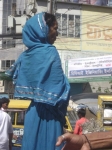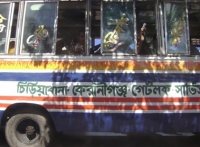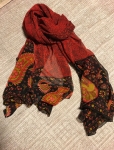The Girl in the Street (Version Two)
People in this world have problems; problems of their own, problems belonging to others, problems that have no names… everyone has these. If you have smaller problems, you may slide into happiness once in a while. If the problem is bigger, other smaller problems might add onto that and life may become more ‘hair-raising’. We human beings are known for our urge for survival, but does living with problems equal survival? And does it lead us towards a better life or does it take us further away? Now, that's a question we may never think to ask.
Hello, I am the girl in the street, who observes and judges people by their momentary appearance. The plan is to watch someone about whom I have zero background information, and to make the most surprising assumptions about their greatest secret, and no, it is not important to get it right.
It is my habit to wander around Dhaka, looking for interesting characters to observe. I am a people-watcher! Of course, this is not a real job. In fact, I am a just one of the millions of young women in this great city. Most of the time, as a young mother, I live a pretty ordinary kind of life, but I have a great imagination, and sometimes, when I feel life has become a little dull, I go out and about in this crowded city. I like to watch people simply for my own entertainment.
Now, let us begin with subject number one… In this case, it is crucial for me to call the human beings I watch subjects, since it feels to me that I am involved in a kind of research experiment. Since I am not a real researcher, I should probably not think of humans as experimental subjects, but each of us is a unique human being with our own unique characteristics, perspectives and intentions, so I guess, since I am trying to discover some crucial piece of information about each person I watch, that's not a completely new position to take.
To get back on track, the young woman I am watching today looks to be about my age, possibly 22 or 23, but somehow she has managed to look older and more pale. She has a daughter with her, about five years old. Surely, she must care for her, I think, because that's what mothers do, but to me, she looks disappointed and mostly tired. I need some kind of back-up evidence to support my view, so I look for signs, but I find nothing but her eyes... her dark-circled eyes… which seem to be looking for someone kind to help her bear her heavy responsibilities. But there she is, holding her biggest responsibility herself, her daughter, in her own narrow and delicate hands.

We are sitting in the front seat of a typical wreck of a Dhaka bus. Before us, as is the common fate of vehicles in this city, there is only cracked glass to focus on, and on this grey day the pale light that barely shines through the dirty broken window seems to match the young woman’s low spirits. The bus driver seems to be aiming for maximum horsepower, and is driving at ‘break-neck speed’.
We are being thrown around inside the bus at a frightening rate. We have to catch hold of our seats tightly, so that we don't crash our souls into that damaged glass. I manage to do so only by using all my strength; yet it seems she, holding tightly onto her child, has to spend even more! She seems frozen in fear, perhaps by the fact that no-one is with her who will help her to stay safely where she is right at this moment. She clearly cannot afford to make more effort to protect her child. Neither does the knot she has tied in her orna*, around them both, help her at all! The look on her face makes me wonder, would the one with whom she has ‘tied the knot’ help her, if he were here right now?

All this may not sound so dramatic to you, because such things surely happen to everyone in the course of everyday life, especially in the breath-stopping madness that characterise these over-crowded city streets of ours, don’t you think? If we are lucky, and they do not, then the demands of our precious society will surely find another way to add to our load, and push us beneath some other surprising and heavy responsibility, perhaps. It is unavoidable, right? Why should we expect things to be otherwise? This young woman simply does what she has to do and does not give up, even if she wants to!
My observation of her leads me along a track that reveals her to possess a finely-tuned low sense of self-worth. She seems, from her struggling expression, to be experiencing some kind of inner struggle. But then again, we all suffer from that, right?
So will she ever know, while holding tightly onto the safety rail with her right hand and, with the other, balancing her daughter and seizing her hand-bag equally tightly, that she was so closely watched by a very curious observer! And if she does, will she take that as an insult and feel annoyed at the added discomfort that her observer has made her feel?
As I wonder about this, I notice that I am looking straight at a clear area in the glass of the window beside me. All of a sudden, I realise that I have, for some time, been looking, with empty eyes, at a very familiar reflection.
That’s right, the young woman that I have been observing… is myself! It is my own hand-bag I am trying to keep hold of, and my own precious daughter whom I am holding so tightly against my body. The knot in my orna is the same knot I had earlier tied to keep us safely together. I take a deep breath, then blow it out slowly... so slowly… I look again, just to be sure. Yes, it is my own dark-circled eyes that I have been looking at so hard and for so long. The window beside me clouds over with my breath. I wonder how it is that I have allowed my problems to remove me from reality... from myself…
But the bigger question is, will any of us ever be able to ask ourselves honestly about the knots we have tied around ourselves in life, the problems that we so often hide under our seats, the worries we hang onto so tightly, hoping that they never wander around in the broad daylight for everyone else to see!

*Orna = Long fabric shawl or scarf draped around the body and sometimes over the head.
_____________________________________________________________________________________
Learning Activities
Vocabulary List: learn all of the words from the following list. All of these words are high frequency academic words that are necessary to know if you plan to study at tertiary level. They can all be found on the Academic Word List (AWL).
| assumptions | evidence | maximum | reveals |
| complex | identity | perspectives | survival |
| crucial | involved | removed | unique |
| dramatic | job | research | vehicles |
For more information about the Academic Word List, please visit
https://www.wgtn.ac.nz/lals/resources/academicwordlist/awl-headwords
_____________________________________________________________________________________
Do you know the meaning of these expressions?
Idioms
-
‘hair-raising’ = frightening, difficult to face
-
to ‘tie the knot’ = to marry someone
-
to travel at ‘break-neck speed’ = to go very fast
_____________________________________________________________________________________
Reading Critically:
-
Evaluating: How would you respond to the narrator’s reflective questions, “We, human beings, are known for our urge for survival, but does living with problems equal survival? And does it lead us towards a better life, or does it take us further away?” Give some examples and reasons to support your response.
-
Applying and Creating: The young woman telling the story seems to be in a state of psychological distress. She describes herself as if she is an observer watching a different person, and she seems shocked when she realises that she has been thinking about herself all along. It seems she may be having some problems in her life. What kinds of problems do you imagine she may be having? For every problem you imagine, try to think of some advice to give and/or a possible solution.
-
Analysing: What do you think is the main message the author of the story is trying to convey to the reader? Explain your answer using information from the story to support your ideas.
Forming Opinions:
-
Read the Pre-intermediate version of this same story (“The Girl in the Street” - Version One), that is also on this site. Compare the two stories. How are they similar and how are they different? Which story do you prefer and why? Explain your answer in English to a partner.
-
Work with someone else who has also read both stories. Share your opinions with each other in English. As you speak, try to use as many words from the word list above as you can. Make sure to sue the words in your own original way.
Writing and Speaking:
Create two short conversations (in writing) using the following two idioms.
-
‘hair-raising’
-
to ‘tie the knot’
Make sure that your conversations make the meaning of each idiom clear. In each conversation, underline or highlight the idiom that you use, and also the other part of the conversation that shows what it means. Here is an example using the idiom ‘break-neck speed’ to show you what to do.
Example:
Speaker A: Wow, you’re really late this morning! What happened?
Speaker B: I am lucky to be alive! My father drove me here at break-neck speed. We all woke up so late this morning and we had to hurry. We were driving so fast, I thought we were going to have an accident!
Speaker A: Well, I’m glad you made it safely. I hope you don’t have the same problem tomorrow morning.
Speaker B: Me too!
Practise your conversations with a partner. When you are ready, perform your conversations with another pair.